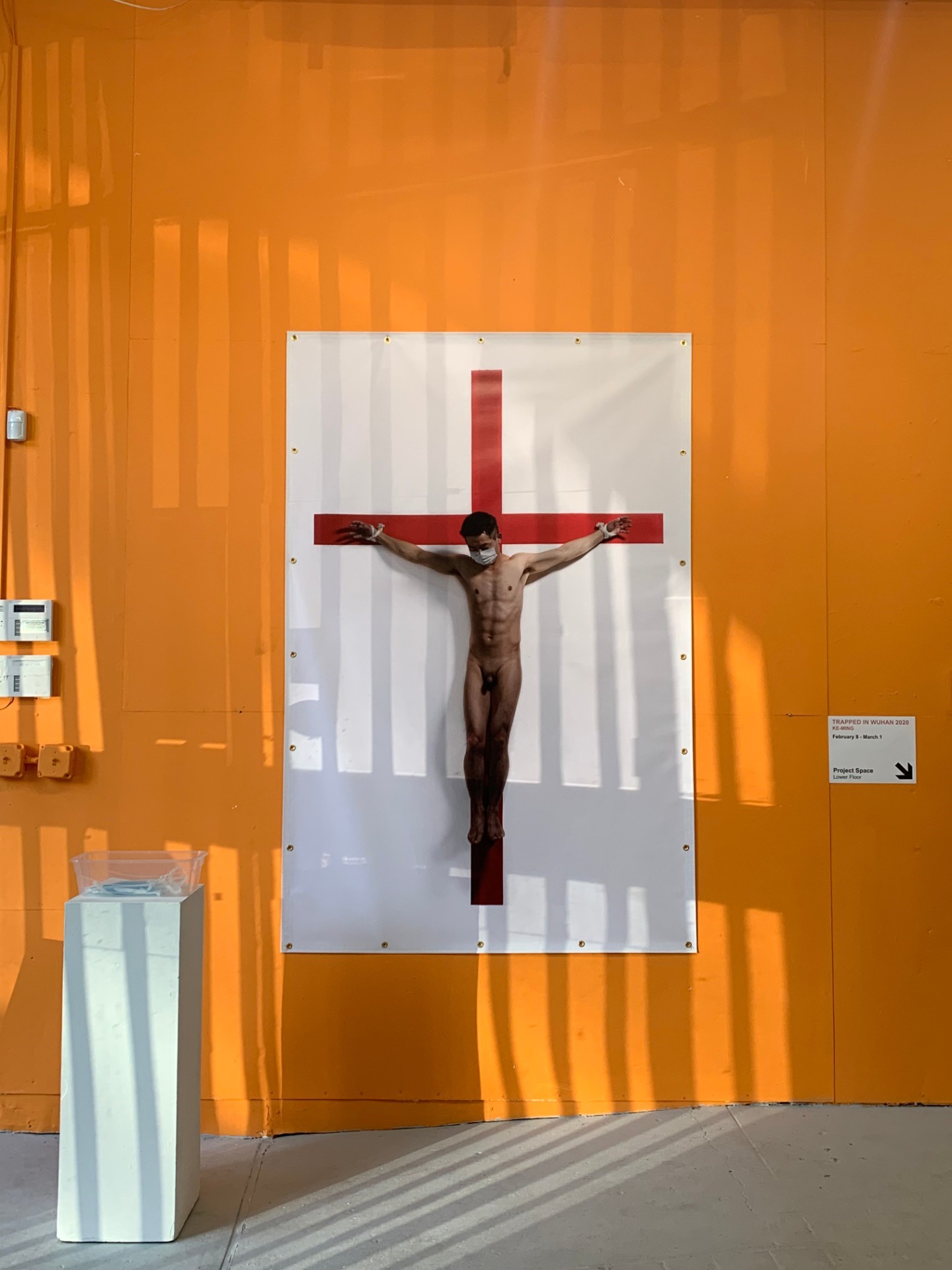In early January 2020, the new coronavirus Covid-19 broke out in Wuhan and swept through cities across China. With the severity of the epidemic escalating, on January 23rd, the Wuhan government decided to put the city in lock down. And due to this, the artist Ke Ming missed the opening ceremony of his solo exhibition at Whitebox in New York.
Ke Ming, born in 1980, is a conceptual artist who is currently living in Wuhan. His work often takes the form of a whole project involving the usages of multiple medias, rather than single pieces. Ke Ming’s works often focus on the social circumstances that people live under; attention to real world problems is a common motif across his works.

“People’s Currency-Absurd Realism NO.05” Conceptual Installation 2016

“People’s Grass”, sheep feces, 2018
Ke Ming was planning to name his solo exhibition ‘Cross’ before the virus outbreak, a show which would center around concerns about the impact of globalization on human life, and the social problems of Chinese society, i.e. those that occured as a consequence of its rapid development in recent years. As the situation escalated, Ke Ming decided to make some changes to his solo exhibition. We can find documentation about Ke Ming’s thoughts and feelings during the lockdown on his Weibo. On February 23, one month after the city was put on lockdown, Ke Ming released a post: ‘Recalling when I first heard the news [that Wuhan is put on lockdown], I didn’t felt that it would have anything to do with me. I found the novelty exciting and with curiosity, I drove around zone 3 and even fucking filmed the entire trip. On the second day, I was informed that my good friend and colleague tested positive and I have suddenly became a C-type patient, a potential carrier of the virus…’ The scale of unfortunate news from relatives and friends who were close to Ke Ming broke his initial attitude about the epidemic. Ke Ming started to do everything he could to help. He also started to document everything around him. With the intention of leaving a record for things that have happened in Wuhan, and letting the rest of the world know the severity of the situation, Ke Ming decided to change the theme of his solo exhibition from ‘Cross’ to ‘Trapped in Wuhan’.
In the exhibition, which is renamed as “Trapped in Wuhan”, Ke Ming has photoshoped a mask over the original work. Looking at the crucified artist who is wearing a white mask over his face, and also getting a first-hand video account of the scene in Wuhan, Ke Ming’s message is more than obvious.

‘Trapped in Wuhan’ at display in Whitebox, conceptual photography, 2020

A scene from the production documentary of ‘Trapped in Wuhan’ 2020

A scene from the production documentary of ‘Trapped in Wuhan’ 2020
Apart from ‘Trapped in Wuhan’, the 22-meter-long multi-media work ‘The Great Wall’ from Ke’s solo exhibition is also impressive. ‘The Great Wall’ is a piece created by Ke Ming based on graduation photos from China Normal University (Wuhan). The artist is sitting naked in the front row at the center of the picture, and we can also see his face appearing at different places within the ‘graduation’. What’s most striking about this unusual group photo is probably the replacement of some students and teachers’ faces with portraits of historical figures. These square images looks like rough copy-and-paste products that stand out from the crowd. This epidemic casts a different meaning over the original work. In the context of the epidemic, it is difficult for us to treat the people shown as only visual elements of Ke Ming’s work. It is hard not to wonder how many of them stayed in Wuhan? And how the outbreak affected their lives?

Details of ‘The Great Wall’ 2020

Details of ‘The Great Wall’ 2020

Details of ‘The Great Wall’ 2020
Although both the title and arrangement of the work seem to suggest that the Great Wall should be the starting point for its interpretation, after Trump ’s election campaign (Trump has repeatedly declared that he will build a great wall on the border between Mexico and the United States in this campaign (‘a Great, Great Wall’).), the title ‘The Great Wall’ reminds one immediately of a wall itself, rather than the famous sight in China. ‘Wall’ is more often than not slang that Chinese netizens use for denoting censorship. As an ancient defense project against foreign invasion, the Great Wall performed just such function — resisting outsiders. The Great Wall protects its inhabitants, while keeping them in captivity. When we consider a ‘Great Wall’ as a symbol for certain social mechanism, ‘The Great Wall’ not only shows us the scale of the individuals that are affected by the Wuhan epidemic virus, but also reveals the width and depth at which this mechanism influences everyone. Looking at Ke Ming’s work, the 6,000 teachers and students that collectively make up the 22-meter-long wall are in essence a representation of the Chinese netizens, and those abrupt intruding pictures are like representations of information which inadvertently make their way into this locked-down community. We occasionally see different faces from the silent majority.
In the era in which 9 million people are collectively ‘trapped in Wuhan’, there used to be information about Dr. Ai Fen readily available, but now she has probably disappeared behind the ‘Great Wall’. Ai Fen is the director of the emergency department of Wuhan Central Hospital. On December 30, 2019, one month before the outbreak of coronavirus epidemic, she received a test report of patient with pneumonia. She highlighted the part of the report where it states “SARA Coronavirus” and forwarded it to her classmates who are also doctors (the classmate ask her about the situation first). The intention was to alarm medical staffs to be aware and stay cautious. This report was later forwarded by the well-known whistleblower Dr. Li Wenliang. On March 10th, ‘People’ published an interview with Ai Fen, but it did last through the night. Before morning, one could only see ‘this content cannot be viewed because of violations of relative laws’ when trying to open the interview.
In order to prevent the information from disappearing behind the great wall, Chinese netizens has started to circulate the interview voluntarily. When the usual means of avoiding censorship weren’t effective, netizens started to create unconventional formats for preserving the message (see our last article on the issue). Some even went through the trouble of storage the information using blockchain, a form of decentralized internet which could help to preserve the content permanently. With the password, anybody could view it using the Ethereum previewer.

The interview coded in the format of Pinyin

The interview coded in the format of barcode.

The interview reproduced in hexadecimal
The existence of the great wall seems to have become a common ‘view’ that accompanies the daily life of Chinese netizens, but as the digital age develops, and with the collective reflection on freedom of speech revealed through this epidemic, maybe one day we will see the distant horizon.
Disclaimer: The content of the article only represents the personal opinion of the author.

